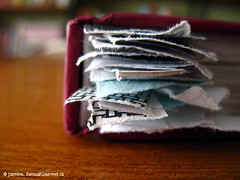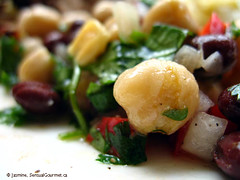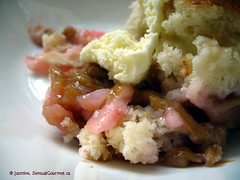 Thanks to the kind people at Harper Collins Canada, I found a copy of Anita Stewart's Canada in my hot little hands.
Thanks to the kind people at Harper Collins Canada, I found a copy of Anita Stewart's Canada in my hot little hands.Anita Stewart’s Canada
By Anita Stewart
Harper Collins Canada
336 pages; $34.95
I must admit when I heard that Anita Stewart (aka “Wonder Woman of Canadian Cuisine”) was undertaking what sounded to me like the equivalent of The Big Book of Canadian Cooking, I looked forward to what she’d present.
For those of you who don’t know Stewart, she’s a culinary icon up here. Passionate about Canadian food along with the people who grow, produce, cook and eat it, this culinary activist and “gastronomer” spent 30 years discovering and trying to define Canadian Cuisine. Her journey includes penning 14 cookbooks (including this one) and a regular gig on CBC Radio One’s Fresh Air. The founder of Cuisine Canada, an organisation for food professionals that promotes fine Canadian food and wine, while administering Canadian cookbook awards, she also sits on the jury of the World Food Media Awards.
Anita Stewart's Canada is part cookery book, part reference book encompassing bits of anthropology, botany, history and sociology, and part call to arms regarding local eating and food production, all punctuated with photographs taken by her or Robert Wigington.
Because of how the book is put together, I think the writing is of greater importance than in most other cookbooks. Stewart’s writing is easily divisible into three voices –the storyteller, the research historian and the food activist:
Stewart the storyteller includes some of the interesting people she’s met in her travels such as Diane Bernard who harvests seaweed, Roger Dufau who owned Toronto’s Le Petit Gourmet and Devini DeSilva, a research associate at the University of Saskatchewan. Stewart’s storytelling draws in the reader to how these people or their foods have added to Canadian eating.
Stewart the research historian can weave an interesting story such as the Three Sisters soup and its ingredients' roles in First Nations’ culture but she can mire the reader in dry facts and figures such as the nutritional benefits of oats. One of the more interesting facets of this book is how she tracks immigrant groups and their stories: sidebars on groups such as the Brazilians, Iranians, Jamaicans, Malaysians, Portuguese and Swiss in Canada help to provide readers a fuller picture of who it is that makes up this nation.
Stewart the food activist is earnest but quite honestly comes off as a bit preachy. Because of that I think it’s the least impressive and effective of the three—granted this could be because I am generally fatigued by the seemingly unending influx of food activist-warriors. Whether she’s telling us that the Atlantic Salmon Federation is “ringing alarm bells and mobilizing volunteers” or being “blown away” by a sac of potatoes endorsed by the World Wildlife Federation, I think there could be a more successful way of relaying this information to readers.
A reference book is really only of use if it has a good and thorough index. Unfortunately, this one doesn’t. A few weeks after reading it, I wanted to find a particular recipe, but could only remember its originating culture. Other recipes were listed, but not this one. After a couple of attempts with main ingredients, I finally found it. Add to this my trying to find a specific reference to Samuel de Champlain (who is mentioned throughout the book) and the L’ordre de bon temps, and I was more than frustrated when neither appeared in the index.
This book’s strengths lie in its cookery portion. Quite honestly: I like it. I think it identifies the many flavours and facets of Canadian cuisine and makes people think beyond the obvious.
The book isn’t divided into the traditional breakfast, lunch, supper, snacks, dessert and other. Nor is it really broken into headings such as breads, meats and drinks. Stewart has instead cleverly divided the collected 150-ish recipes into main ingredients, to certain extent mimicking their introductions to Canada’s dinner table. She starts with the Original Palate (what was here before European settlement), then discusses Maple Honey and Molasses, Corn Beans and Squash, Salmon, Fish and Shellfish, Meat and Poultry, then Gran, Potatoes, Dairy and Eggs, Fruit and Nuts and ends with what she calls The Contemporary Palate (partly the product of food science, partly the product of early 21st Century tastes and fashions).
Here she delves into samplings some of the many cultures which have found their ways to Canada. You can find recipes for Australian Pavlova, Finnish Coffee Bread, Greek Bougatsa, Japanese Gyozas, Malaysian Curry Chicken with Potatoes, Ismaili Peach and Black Pepper Potatoes, Russian-Jewish Halupches and Sri Lankan Coconut Roti along side Buckwheat-Buttermilk Crêpes, Butter Tarts, Classic Chicken and Dumplings, Crispy Potato Pancakes with Smoked Salmon and Maple Pouding Chomeur. I think because so many of the recipes come from home kitchens, they work, are uncomplicated and pretty easy to throw together. They are written with common sense in mind and (at least the ones I tried) came together really easily. Better yet, they were pretty tasty.
 And which recipes did I try? I’ll be very honest and tell you that I have never flagged so many recipes in a cookbook sent to me to review--20ish, I think--they all just looked good. Somehow I narrowed them down to four—two I’d consider “traditionally Canadian” and two representing the cuisines that have added to our national menu.
And which recipes did I try? I’ll be very honest and tell you that I have never flagged so many recipes in a cookbook sent to me to review--20ish, I think--they all just looked good. Somehow I narrowed them down to four—two I’d consider “traditionally Canadian” and two representing the cuisines that have added to our national menu.  Jamaican Jerk Pork (p 126)
Jamaican Jerk Pork (p 126)Whenever I go to a Caribbean restaurant, I gravitate towards the Jerk Pork. I know there are many other delicious things to have, but a good JP is usually why I’m there. I was very surprised at how easy it was to make. My only problem was of my own doing—the scotch bonnets I bought were pretty mild so the pork could have been zippier (but yes, my fingertips were a bit tingly). I’m going to try this again and either increase the number of peppers or try and find hotter peppers.
 Karen’s Brazilian Black Bean and Chickpea Salad (p38)
Karen’s Brazilian Black Bean and Chickpea Salad (p38)In hot weather season I prefer to lunch on chickpea salads. This one is very easy and would do well at a summer barbecue. Its combination of coriander leaf, lime and apple cider give this salad was very pleasant.
 Nova Scotian Rhubarb Cobbler (p267)
Nova Scotian Rhubarb Cobbler (p267)Yup, this is where my rhubarby bounty went. This is one of those recipes that scream springtime in Canada and springtime in someone’s home kitchen. It’s very simple to put together and very satisfying coming out of the oven.
 West Coast Clam Chowder (p90)
West Coast Clam Chowder (p90)A good creamy clam chowder is always welcome in my soup bowl on cold nights. This chowder was so easy to put together and not too bad. I’ll probably make it on a regular basis once the temperatures dip.
Anita Stewart’s Canada is a pretty major undertaking. It traces the many histories of our land—social, cultural and ethnographic as well as botanical and agricultural—and synthesizes this information into a sampling of diverse dishes that donate to the definition of what food is in Canada.
So how does it rate?
Overall: 3.5/5
The breakdown:
Recipe Selection: 4/5
Writing: 2.5/5
Ease of use: 3.5/5
Yum factor: 3.5/5
Table-top test: Pretty much lies flat
Kitchen comfort-level: Novice-intermediate
Pro: It gets people thinking beyond maple syrup, salmon and poutine.
Con: Uneven writing and inadequate index make the prose difficult to get through and specific recipes can be difficult to find.
cheers!
jasmine

11 comments:
I have several Canadian cookbooks in my collection -- most of them books I bought on travels up north, including one in French that I cannot read but seems to have many classic recipes. Not one of the books would I consider "the" book of Canadian cookery, so I was hopeful when reading your review. Alas, a poor index is usually a deal breaker for me.
I have to agree with Lydia, the index is more important than anything else for me, especially because I tend to search for / choose recipes based on a main ingredient and that has made me index dependent, but I will look for it the next time I'm home.
in re: scotch bonnets
The South American store on the east side of Augusta in Kensington Market has just gotten a stash of insanely hot dried habaneros. We've never had such hot peppers! We've not tried their fresh habaneros though.
When making jerk sauce, we've been known to transgress and use Thai chillies instead of scotch bonnets... (I hope the jerk police don't come after us now)
-Elizabeth
P.S. Just in case you'd like to compare jerk sauces, here is our jerk sauce recipe
An index is really difficult to do by hand with a good word processing program much easier but then it's only as good as whoever is tagging things. But I'm with Lydia and Joanne, without a good index and book is of much less use.
Great review Jasmine
New to me and I am loving this! I miss my summers visiting my cousins in Ontario so that might make me feel a little closer!
MMM! My boyfriend's mother just bought this cookbook and I am coveting it already. Perhaps it is my love of books and stories that makes this one so dear - I love the vignettes that accompany all of the recipes.
Great addition to your bookshelf, let me know when you get to the gateaux (a new-found favorite recipe!)
I don't know where you get the energy, you are as thorough as a journalist. I look forward to more book reviews, especially Canadian ones.
Great review Jasmine! It really opened my eye to Canadian cuisine!
Interesting. I've picked this book up several times and each time put it down. I'm not sure what it is but while it does seem enticing, it just doesn't move me to buy it. Your review is amazing, Jasmine! You should be doing this professionally!
Hello all
Glad to know I'm not the only one who weights indices.
Glad you find these useful.
j
I made the Jewish cheesecake recipe from this book, it was hands-down the best cheesecake I've ever had. I was quite worried that it wasn't cooked enough, because it was still wiggly in the middle when it came out of the oven, but by the time it had been properly chilled it was creamy and beautiful.
Post a Comment